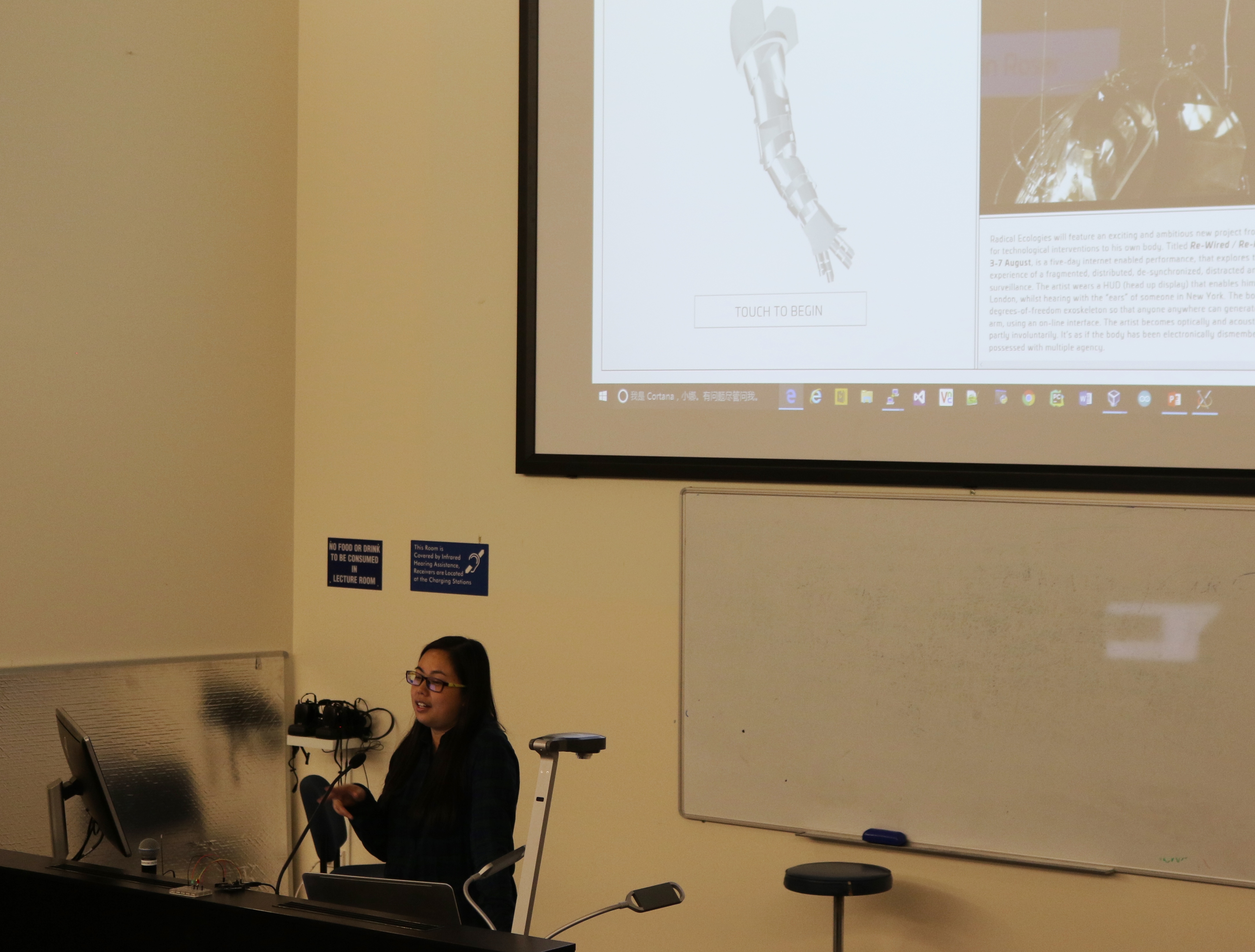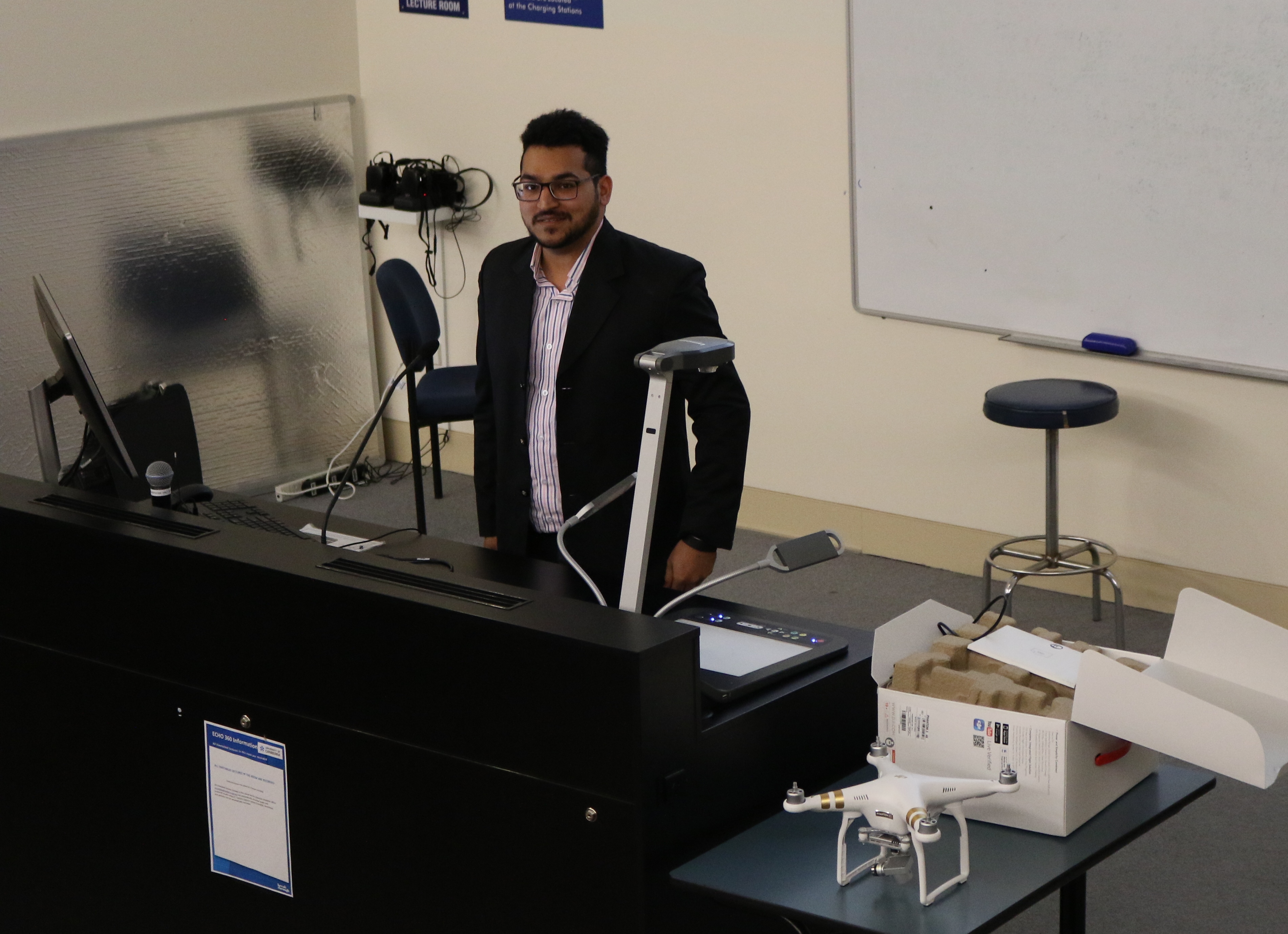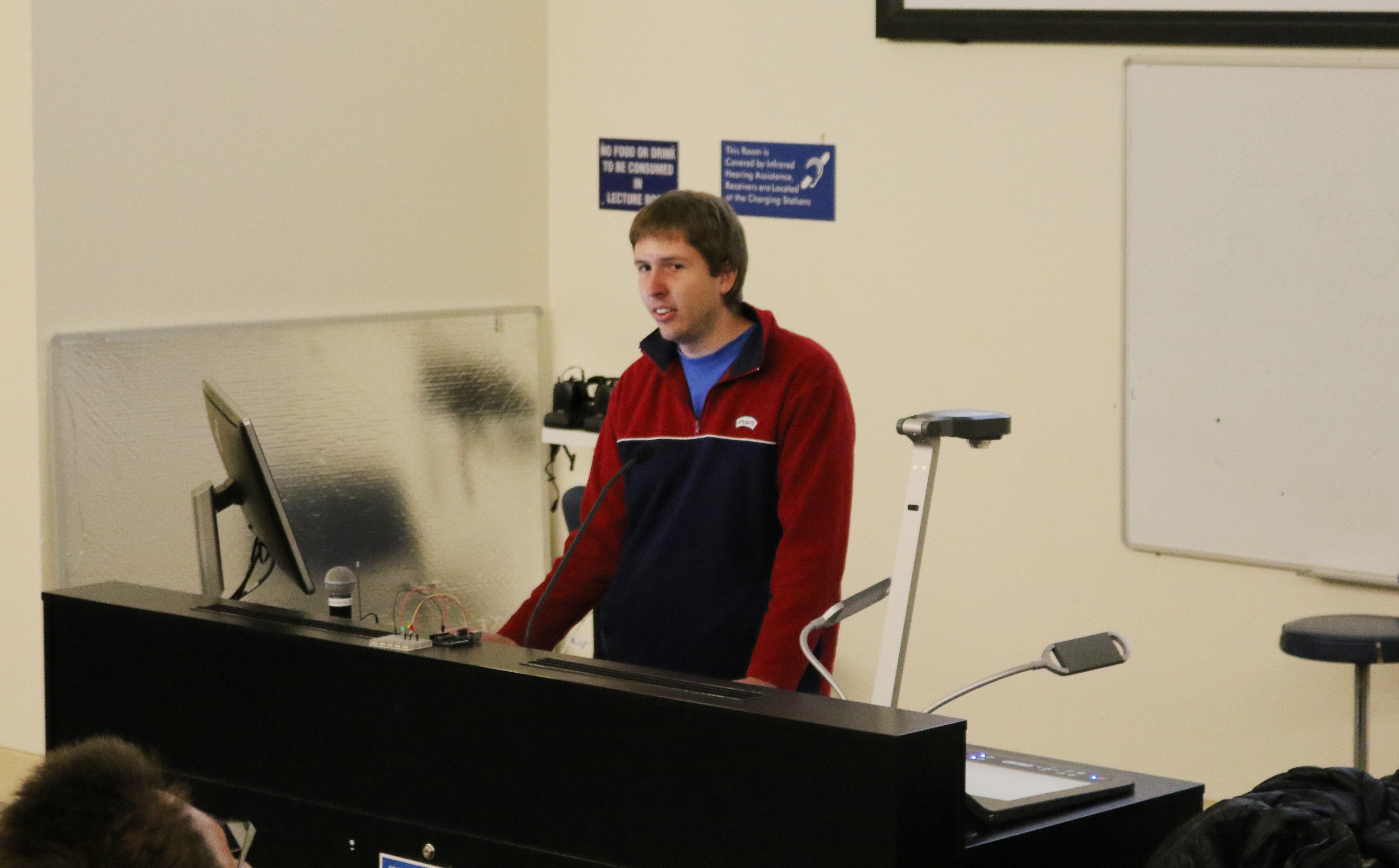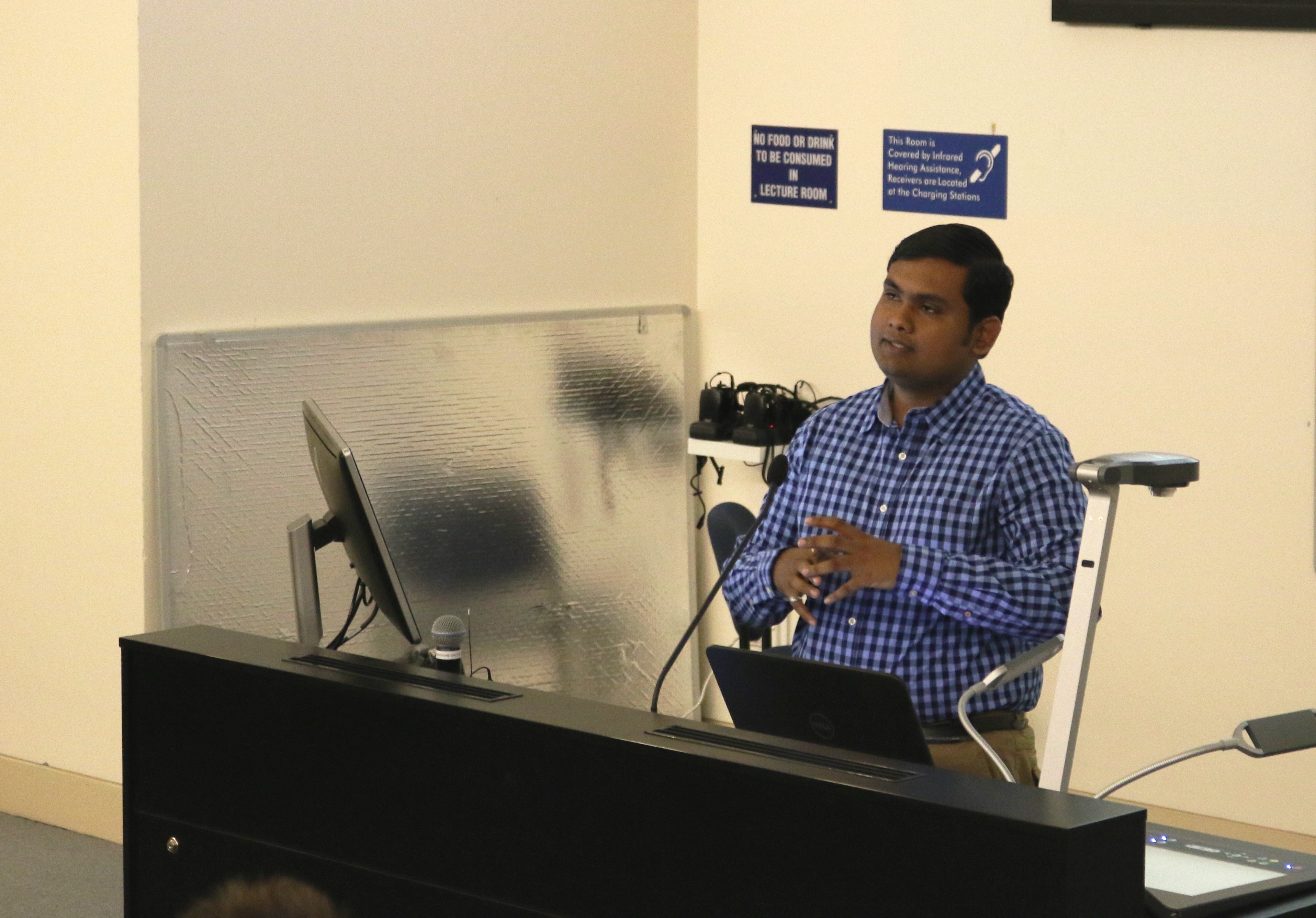Marcus Butler
26 August 2016: Five University of Canberra students spent 10 weeks over winter researching robotics, software and network engineering as part of the Winter Research Scholars (WRS) program.
The WRS program is run by the information technology and engineering unit and offers opportunities for masters and undergraduate students to spend time conducting research projects.
WRS coordinator and associate professor in software engineering Girija Chetty said the program gives students practical experience in conducting research, from reviewing published literature to physical experimentation.
"We try and ensure the students get an accurate idea of what research is," Dr Chetty said. "It's not always whiz-bang lab work, but similarly it is not just about reviewing articles, thinking about the big questions and writing either, so we try and give the scholars a glimpse of both aspects.
"We had students working on projects from robot learning to creating programs to take a person's pulse by video."
At the conclusion of the program the students presented their work to other participants and their supervisors.
Read more about the participants and their research below.
Approaching the final semester of her master of Information Technology and Systems, Ivy Zhu spent 10 weeks in the University's Winter Research Scholars program, investigating how we can empower robots to 'learn' from each other to work more efficiently.
"I studied how we can use 'the cloud' to effectively give robots a group mind to be able to perform their actions better," Ms Zhu said.
"This research will eventually allow robots to share their experience with other robots, it means that they will have a shared memory to perform their work."
Freeing up the robots from having to carry their own memory storage will mean they can be designed with more flexibility and their actions will not be limited by their initial programming.
"One way of thinking about it is to use a hospital scenario. Imagine a serving robot provides an immobile patient with a glass of water and at the same time the robot sees that there are biscuits on the patient's serving tray," she said.
"The information is all sent to the cloud, then when another robot enters the room later in the day and the patient asks for biscuits the second robot has access to the information and knows where the biscuits are already."
Ms Zhu would like to continue looking into robot learning in her final semester and will consider a PhD in the future as well.

James Ireland joined the Winter Research Scholars as an undergraduate, but he's already got some interesting research work under his belt.
Mr Ireland has worked on a smartwatch application which can be used to detect falls in the elderly and automatically send an SMS to a carer or family member alerting them.
During the scholars program James turned his attention to electroencephalography, a subject he laughs is tougher to say than to understand.
"It's basically a machine which can monitor and respond to electrical impulses from a person's brain, by wearing a specially-designed headset.
"My project was to use this headset and a program which I built to allow a person with no use of their body to communicate," he said. "I wanted a system which was similar to Stephen Hawking's computer-assisted speech, but using brainwaves rather than small eye movements."
He described some of the unexpected discoveries he made during the research.
"I found spending half an hour limiting any movement and thinking about a single word to get a response from the computer also resulted in drowsiness and I had a few micro-sleeps.
"I also found the headset was struggling with getting solid readings from people with long hair, so there's a long way to go before it's a reliable development," he said.
Mr Ireland is in the final year of a Bachelor of Software Engineering.
Drones are rapidly advancing in their capabilities, and Mohammed Nizamuddin Rizwan is hopeful his research will put them to an important use saving lives after disaster strikes.
Mr Nizamuddin completed a Master of Information Technology and Systems earlier this year, but he jumped at the opportunity to spend 10 weeks as a Winter Research Scholar.
"I really wanted to add some hands-on research experience to my master's degree and the WRS program was a great opportunity," Mr Nizamuddin said.
"I was impressed with the access I had to UC's academics and other researchers, they were all keen to assist and share their ideas with me about the project."
Mr Nizamuddin focused on the use of drone aircraft to photograph and video disaster scenes to identify where people are located and to inform rescue teams on the ground.
"My project was to create a process to record, analyse and share aerial images to assist in emergency situations, such as the aftermath of natural disasters, major vehicle accidents and similar incidents where there is a risk to further lives," he said.
"I based my initial approach on the idea that no machine is worth as much as a human life, so by equipping machines to provide accurate and detailed information at disaster scenes we can avoid putting people in harm's way.
"I'd love to see whether my project can form the basis of a PhD in the future, I am interested in what other people are doing in this space. I'd love to be able to scale up the project and perhaps use the drone in a simulated environment to see how it responds."

Heading into the Winter Research Scholars program, Tim McCulloch set himself a challenge to design a system which would enable him to take a person's pulse by video.
"I took on this this problem because it crossed over with my other interests, like computer vision and processing," Mr McCulloch said.
"I was able to experiment with code writing and video magnification. I think the best thing about the entire scholars program was when I first saw the results and seeing that it really is possible to see someone's heartrate."
His system focuses on the tiny changes in skin tone and colour which can't be seen by the human eye, but can be picked-up and enhanced by computer.
The end result is a video of a person with a rhythmically pulsing green colour over their face, which matches their heart rate.
"The project is something that may be useful to clinicians in psychology, because information on a person's heartrate may be helpful in diagnosing depression," he said.
Throughout the program he said he developed a greater appreciation for the entire process of research.
"I enjoyed tinkering and experimenting with my ideas and seeing that work go from idea right through to positive result.
"I did identify some obstacles that will need to be overcome, like if the person being videoed moves their head a lot, then that can throw off the system."
He is working with associate professor of software engineering Damith Herath on a robotics project, and will finish his Bachelor of Engineering in Network and Software Engineering this year.

Kiran Wagh was so excited by his experiences during the Winter Research Scholars program that he's ready to jump into a PhD.
"It's been an amazing experience, I've picked up so many new things and I'm really interested in continuing as a researcher," Mr Wagh said.
He has completed his Master of Information Technology and Systems, and is exploring the possibility of launching into some further study.
He focused his research project on building a system to monitor sedentary activity in people.
"There are so many activity tracker devices, that record your movements, your steps, kilometres travelled and calories burned, but there's very little that gauges a lack of activity," he said.
"Between the modern work environment and popular ways to spend leisure time almost everyone is living more sedentary lives.
"My work helped to create a fusion between 'hard sensors' inside a smartphone and 'soft sensors' through Facebook to be able to assess a person's sedentary state.
"It wasn't all smooth sailing, I found things like leaving the phone on your desk while walking around the office would skew the readings, but for the most part it did give an accurate representation of the time someone spent not moving."
Mr Wagh praised the WRS program as a great way to experience the work of a researcher, to promote interaction with other people already researching in ICT and to build connections with researchers at the University of Canberra and around the world.



